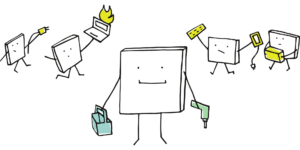
Part Two: Institutional Strategies to Improve Student Success …
… While also Improving the Institution!
Pam Sornson, JD
June 20, 2023
Assuring ‘student success’ is not rooted solely in supporting the learner’s effort, as was discussed in Part One of this series. In this second part, we offer insights and suggestions on how improving institutional practices can also increase the likelihood that the success of the students will follow.

Identifying a Baseline
To be truly ready to educate tomorrow’s college students and workforce participants, today’s higher education leaders must prepare their organization to accept the adaptations that are coming. Multiple influences are currently washing over schools and communities that promise to be significant change agents at both the instructional and career implementation levels. Two advancing realities, however, are driving the most innovation: the impact of the pandemic, and technology, specifically artificial intelligence (AI) and machine learning (ML).

Covid’s Lingering Impact
Consider it ‘long COVID at the community level.’ While the virus’s lethality appears to be contained, its repercussions continue to affect millions. From an educational perspective, that lingering is revealing itself in three dimensions:
Delayed K-12 Achievements
Not surprisingly, recently obtained K-12 assessments are revealing significant learning losses and delays in the lower grades. Those deficiencies will need amelioration before the students can continue on an upward educational track. Experts suggest enhancing academic support services throughout all educational systems for at least another five years to ensure adequate resources are available.
Equity Revelations
The equity gap widened during the pandemic interim, too. Communities that were lagging in technological and social advancements before it hit are full-on lacking them now as public resources dwindled or were diverted. Enhanced social services support will be necessary at every college to help make up for those lapses in capacities. On the plus side, an elevated focus on righting inequities may result in the (final) elimination of entrenched, bias-based practices.
Mental Health Erosion
While mental health services were inadequate before COVID hit, they are completely overwhelmed in many communities now, and students of every age are suffering as a result. Stresses brought on by enforced isolation, reduced financial resources, and the loss of community engagement caused millions of learners to reconsider their educational trajectory. In Fall 2021, 65% of community college and 75% of four-year school attendees responded to a Gallup survey that they were seriously considering withdrawing altogether due to pandemic-driven emotional stress. In 2023, those numbers are a little lower but still alarming: 41% of four-year schools and 44% of community college learners continue to contemplate the value of more education.
At the very least, today’s higher education leaders should assess how well their organizations are currently prepared to manage this influx of support service demand; the data indicate that they’ll need to be doing more to be fully able to assist their student body in the coming years.

Emerging Technology
The overnight switch to online learning underscores the critical necessity of today’s technology. Without it, the world would have come to a screeching, disastrous halt in early 2020. Since then, the emergence of AI, in particular, has triggered considerable speculation about its capacity to launch an even larger global disruption.
The lure of AI is apparent: programmed to achieve a very specific purpose, the application appears to automate the thinking process, finding possible solutions to complex questions virtually instantaneously. In a higher ed setting, the ease of accessing an AI opportunity suggests that students may use it to ‘create’ their academic outputs, foregoing the necessary research and study in favor of a speedy – and well-received – document. In fact, 43% of current college students admit that they’ve already used the popular AI app, ChatGPT, to produce some of their work.
Despite this concern, schools are also finding ways to use AI to enhance their connections with their students, existing and potential. Chatbots – those boxes lingering in the bottom right corners of almost every webpage – are actually well-programmed robots that fine-tune their responses as users type in their inquiries. They’ve been deployed in several situations to assist with both school and learner success:
Personalized responses that become ever more granular as the questioning continues help potential students find the precisely right school and program. The ‘bot can scan millions of academic alternatives in nanoseconds, ensuring the delivery of a comprehensive suite of options.
AI also assists with academic advising by offering in-depth information about financing, course work, etc., while also tracking student progress and alerting administrators when concerns arise.
Even mental health concerns can now be assuaged by an automated program, Woebot, which uses “intelligent mood tracking” to help students navigate their inner selves.
Of course, the real challenge of AI (and any other emerging technology) is understanding its benefits to achieve its best possible service while mitigating any known or as-yet-undiscovered issues it might also bring. Every school should consider the opportunities presented by technology and prepare to adapt their practices accordingly.
Remarkably, research into this topic – ‘how well do school practices support student success?’ – reveals very little study has been done on how school choices can inadvertently impede student success, regardless of added social supports. Those resources that do look at the concern couch it from a different perspective, often, as was noted earlier, in an ancillary way. Existing questions found in a highly regarded publication have been modified to include our questions in italics to illustrate the change in thinking necessary to understand our theory. We’ve struck through but left in the original language to clarify the distinctions:
How do our student support services academic and administrative processes influence students’ learning outcomes?
Are we recruiting students from all backgrounds who are the most likely to succeed at our institution?
How do our administrative and academic personnel costs choices and hires align with our mission?
At the very least, the future of a generation of learners is at stake as America’s higher education systems address challenges posed by COVID. At the same time, however, the future of virtually every community is at stake if its current and future workforce doesn’t get the training necessary to build its future economy. Every college must adapt its processes to address these realities if it intends to maintain or enhance its student success metrics.


